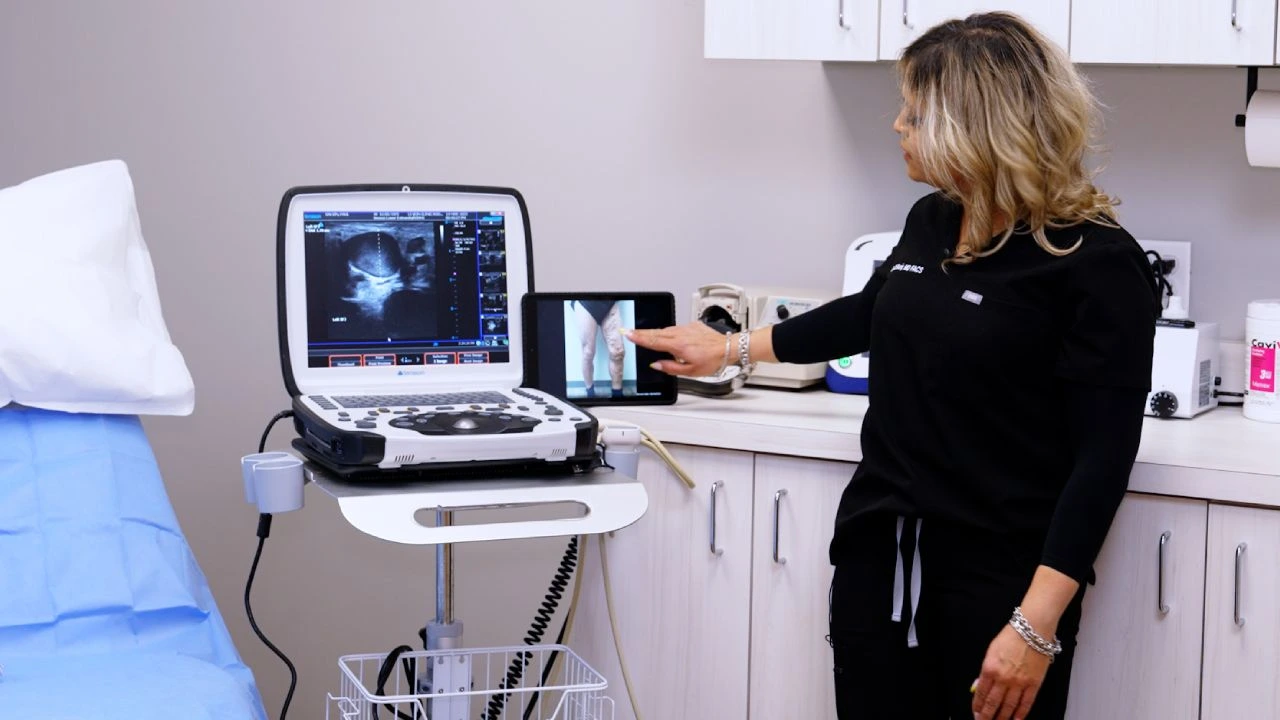Endovenous ablation is one of the most effective minimally invasive treatments for varicose veins and chronic venous insufficiency, the root cause of most vein problems. During a vein ablation, the vein doctor uses thermal energy or laser energy to collapse the diseased saphenous veins and restore effective blood circulation to the heart.
Most of the treated veins will become invisible immediately after the treatment, but some of the dysfunctional veins will gradually fade away from the skin over several months. You may also notice mild bruising and yellowish skin discoloration for a few weeks after the treatment. Endovenous ablation immediately treats vein disease, but the visual improvements may take several weeks.
What does a vein ablation do?
Endovenous ablation is a minimally invasive treatment for chronic venous insufficiency, the root cause of most vein problems. Venous insufficiency is a medical condition wherein your vein valves — components responsible for smooth one-way blood circulation to the heart — collapse or malfunction. When your vein valves malfunction, gravity forces blood to flow backward and accumulate in the leg veins, eventually leading to vascular dilation and varicose veins.
Endovenous ablation involves using thermal or laser energy to treat chronic venous insufficiency. The vein doctor makes a small incision on the skin’s surface (after administering local anesthesia) and inserts a catheter under ultrasound guidance. The catheter is driven into the diseased saphenous vein, following which it’s activated. The catheter delivers radiofrequency waves or laser energy to collapse the diseased vein.
Once the diseased vein is destroyed, the accumulated blood reroutes into healthier leg veins, restoring optimal blood circulation to the heart. As such, vein ablation treats the root cause of all your vein problems. Once the diseased vein is destroyed, your body will turn it into scar tissues that are eventually metabolized. This procedure minimizes the risk of recurrence, ensuring optimal and long-lasting results from your varicose vein treatments.
Does vein ablation always work?
Endovenous radiofrequency ablation and endovenous laser ablation are extremely successful and safe treatments. Vein ablation has a nearly perfect (97%) success rate, and the risk of complications is negligible. Furthermore, vein ablation addresses the root cause of your vein problems, so the likelihood of your spider veins and varicose veins returning is negligible.
Why is my leg still numb after vein ablation?
Temporary numbness is one potential side effect of vein ablation. Approximately 1 in 20 people experience mild numbness after vein ablation, especially on the inside or outside of the ankle. Vein ablation involves using thermal or laser energy to destroy the diseased vein, but it may also damage some of the surrounding nerves, leading to numbness. The numbness will dissipate within a few weeks as the nerve heals completely.
Does vein ablation reduce swelling?
Leg swelling is one of the symptoms of chronic venous insufficiency. As blood accumulates in the leg veins, you experience vascular dilation, leg pain, leg heaviness, restless leg syndrome, muscle cramps, and other symptoms. You may also suffer from leg swelling because of fluid accumulation and poor blood circulation. Vein ablation destroys the diseased saphenous vein responsible for your vein problems, so it also eases swelling and discomfort.
Does vein ablation help circulation?
The primary goal of vein ablation is to improve blood circulation. Chronic venous insufficiency is a circulatory disorder because it prevents effective blood flow to the heart. Instead, blood flows backward and accumulates in the leg veins, leading to spider veins and varicose veins. Vein ablation destroys the diseased saphenous vein and reroutes the accumulated blood into healthier leg veins. Consequently, vein ablation also improves overall blood circulation.
Can I wear knee-high compression socks after vein ablation?
You have to wear knee-high compression socks for at least two days after your vein ablation. Compression stockings apply pressure on your leg veins, thus pushing some of the accumulated blood towards the heart. They also prevent more blood from accumulating in the leg veins. You should wear compression stockings after vein ablation to minimize the risk of harsh side effects and complications, such as deep vein thrombosis. After the first two days of constantly wearing compression stockings, you can start wearing them for a few hours a day for up to 4 weeks.
How long do you wear compression stockings after vein ablation?
You can wear compression stockings for a few hours a day for up to 4 weeks. Compression stockings improve blood circulation to the heart and minimize the risk of vein disease recurrence, making them essential during your post-treatment recovery.
Can ablation cause blood clots?
Deep vein thrombosis, i.e., blood clots in leg veins, is one of the potential complications of endovenous ablation. But our vein doctors take all precautions necessary to ensure optimal safety and avoid blood clots. The risk of blood clots is also negligible. You can further minimize the risk of blood clots by wearing compression stockings, walking frequently, and avoiding strenuous exercise for a few days after vein ablation.
What happens to blood flow after vein ablation?
After vein ablation, the accumulated blood in your diseased saphenous vein will automatically reroute into healthier leg veins. Over time, the diseased saphenous vein will harden into scar tissues and fade away.
If you have any other questions about vein ablation or other minimally invasive spider vein and varicose vein treatments, please schedule an appointment at our vein treatment clinics.










